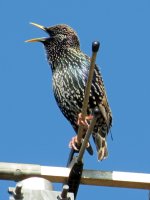Oops, I got distracted while responding to Kevin and didn't see that people had already..... will go ahead and chip in, cause I have to run and I included a link, for what it's worth...
Kevin, I'm a techno-phobe and probably shouldn't be the one trying to answer your question. Since no one else is jumping in though, I'll give it a shot.....
The SX 50 (and the SX60) has two buttons on the left side of the barrel. The upper button is called the zoom assist (I think) and it's very helpful when trying to find your subject at long zoom ranges. When you press this button and hold it, the lens retracts, giving you a wider field of view. Once you're "on the bird" you release it, and the lens automatically goes back out to the focal length you'd chosen. Hopefully, the bird's in the frame and you get the shot. If not, you can press the button again and sometimes this will allow you to re-find the bird without removing your eye from the viewfinder.
Right below the ZA button is the one Neil was referring to. I believe it's called the frame assist, and it's supposed to help with image stabilization in hand-held shots....don't think there'd be any reason to use it on a tripod.
I'd never used this function til trying the SX60, but have been playing around with it since (on my SX50) and don't think it improves my results. That could be because I find it's placement to be awkward, and actually end up moving the camera around more trying to find the button and keep it engaged. Reading around a little, I found that others aren't impressed with it either;
http://www.dpreview.com/forums/post/50277062 Nobody seems to care though, since the IS is good without.
The SX60 is a different ball of wax. In my limited experience, I found one had to use this button just to hold the image still enough to see if the camera was focusing. To me, it didn't seem to actually improve focus, maybe was even a little detrimental. I wonder if using it changes shutter speed as it does on the SX50 and that's why IQ isn't as good at long zoom range. Or maybe I'm just too old and shaky to keep up with technology.....better get checked for cataracts!









